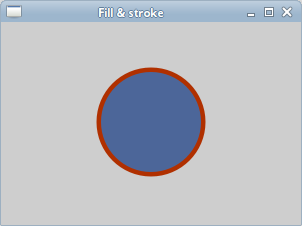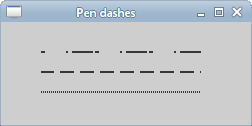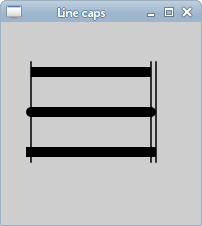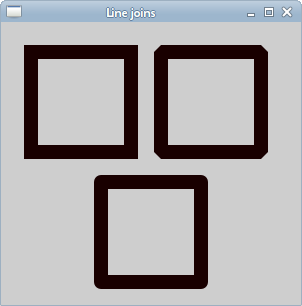Basic drawing in Cairo
last modified July 17, 2023
In this part of the Cairo graphics tutorial, we draw some basic primitives. We draw simple lines, use fill and stroke operations, we talk about dashes, line caps and line joins.
Lines
Lines are very basic vector objects. To draw a line, we use two function calls.
The starting point is specified with the cairo_move_to call.
The ending point of a line is specified with the
cairo_line_to call.
#include <cairo.h>
#include <gtk/gtk.h>
static void do_drawing(cairo_t *);
struct {
int count;
double coordx[100];
double coordy[100];
} glob;
static gboolean on_draw_event(GtkWidget *widget, cairo_t *cr,
gpointer user_data)
{
do_drawing(cr);
return FALSE;
}
static void do_drawing(cairo_t *cr)
{
cairo_set_source_rgb(cr, 0, 0, 0);
cairo_set_line_width(cr, 0.5);
int i, j;
for (i = 0; i <= glob.count - 1; i++ ) {
for (j = 0; j <= glob.count - 1; j++ ) {
cairo_move_to(cr, glob.coordx[i], glob.coordy[i]);
cairo_line_to(cr, glob.coordx[j], glob.coordy[j]);
}
}
glob.count = 0;
cairo_stroke(cr);
}
static gboolean clicked(GtkWidget *widget, GdkEventButton *event,
gpointer user_data)
{
if (event->button == 1) {
glob.coordx[glob.count] = event->x;
glob.coordy[glob.count++] = event->y;
}
if (event->button == 3) {
gtk_widget_queue_draw(widget);
}
return TRUE;
}
int main(int argc, char *argv[])
{
GtkWidget *window;
GtkWidget *darea;
glob.count = 0;
gtk_init(&argc, &argv);
window = gtk_window_new(GTK_WINDOW_TOPLEVEL);
darea = gtk_drawing_area_new();
gtk_container_add(GTK_CONTAINER(window), darea);
gtk_widget_add_events(window, GDK_BUTTON_PRESS_MASK);
g_signal_connect(G_OBJECT(darea), "draw",
G_CALLBACK(on_draw_event), NULL);
g_signal_connect(window, "destroy",
G_CALLBACK(gtk_main_quit), NULL);
g_signal_connect(window, "button-press-event",
G_CALLBACK(clicked), NULL);
gtk_window_set_position(GTK_WINDOW(window), GTK_WIN_POS_CENTER);
gtk_window_set_default_size(GTK_WINDOW(window), 400, 300);
gtk_window_set_title(GTK_WINDOW(window), "Lines");
gtk_widget_show_all(window);
gtk_main();
return 0;
}
In our example, we click randomly on a window with a left mouse button. Each click is stored in an array. When we right click on the window, all points are connected with every point in the array. This way, we can create some interesting objects. Right clicking on the drawn object clears the window, and we can click another object.
cairo_set_source_rgb(cr, 0, 0, 0); cairo_set_line_width (cr, 0.5);
The lines will be drawn in black ink and will be 0.5 points wide.
int i, j;
for (i = 0; i <= glob.count - 1; i++ ) {
for (j = 0; j <= glob.count - 1; j++ ) {
cairo_move_to(cr, glob.coordx[i], glob.coordy[i]);
cairo_line_to(cr, glob.coordx[j], glob.coordy[j]);
}
}
We connect every point from the array to every other point.
cairo_stroke(cr);
The cairo_stroke call draws the lines.
g_signal_connect(window, "button-press-event",
G_CALLBACK(clicked), NULL);
We connect the button-press-event to the clicked callback.
if (event->button == 1) {
glob.coordx[glob.count] = event->x;
glob.coordy[glob.count++] = event->y;
}
Inside the clicked callback, we determine if we there was a left or right click. If we click with a left mouse button, we store the x, y coordinates into the arrays.
if (event->button == 3) {
gtk_widget_queue_draw(widget);
}
By right clicking, we redraw the window.

Fill and stroke
The stroke operation draws the outlines of shapes and the fill operation fills the insides of shapes.
#include <cairo.h>
#include <gtk/gtk.h>
#include <math.h>
static void do_drawing(cairo_t *, GtkWidget *);
static gboolean on_draw_event(GtkWidget *widget, cairo_t *cr,
gpointer user_data)
{
do_drawing(cr, widget);
return FALSE;
}
static void do_drawing(cairo_t *cr, GtkWidget *widget)
{
GtkWidget *win = gtk_widget_get_toplevel(widget);
int width, height;
gtk_window_get_size(GTK_WINDOW(win), &width, &height);
cairo_set_line_width(cr, 9);
cairo_set_source_rgb(cr, 0.69, 0.19, 0);
cairo_translate(cr, width/2, height/2);
cairo_arc(cr, 0, 0, 50, 0, 2 * M_PI);
cairo_stroke_preserve(cr);
cairo_set_source_rgb(cr, 0.3, 0.4, 0.6);
cairo_fill(cr);
}
int main (int argc, char *argv[])
{
GtkWidget *window;
GtkWidget *darea;
gtk_init(&argc, &argv);
window = gtk_window_new(GTK_WINDOW_TOPLEVEL);
darea = gtk_drawing_area_new();
gtk_container_add(GTK_CONTAINER(window), darea);
g_signal_connect(G_OBJECT(darea), "draw",
G_CALLBACK(on_draw_event), NULL);
g_signal_connect(G_OBJECT(window), "destroy",
G_CALLBACK(gtk_main_quit), NULL);
gtk_window_set_position(GTK_WINDOW(window), GTK_WIN_POS_CENTER);
gtk_window_set_default_size(GTK_WINDOW(window), 300, 200);
gtk_window_set_title(GTK_WINDOW(window), "Fill & stroke");
gtk_widget_show_all(window);
gtk_main();
return 0;
}
In our example we draw a circle and fill it with a solid color.
#include <math.h>
This header file is needed for the M_PI constant.
GtkWidget *win = gtk_widget_get_toplevel(widget); int width, height; gtk_window_get_size(GTK_WINDOW(win), &width, &height);
Here we get the width and height of the window. We need these values when we draw the circle. The circle will be resized when we resize the window.
cairo_set_line_width(cr, 9); cairo_set_source_rgb(cr, 0.69, 0.19, 0);
We set a line width with the set_line_width method. We set the
source to some dark red colour using the set_source_rgb method.
cairo_translate(cr, width/2, height/2); cairo_arc(cr, 0, 0, 50, 0, 2 * M_PI); cairo_stroke_preserve(cr);
With the cairo_translate method, we move the drawing origin to the
center of the window. We want our circle to be centered. The arc method
adds a new circular path to the cairo drawing context. Finally, the
stroke_preserve method draws the outline of the circle. Unlike
the stroke method, it also preserves the shape for later drawing.
cairo_set_source_rgb(cr, 0.3, 0.4, 0.6); cairo_fill(cr);
Here we fill the cirle with blue color.

Pen dashes
Each line can be drawn with a different pen dash. It defines the style of the line.
The dash is used by the cairo_stroke function call.
The dash pattern is specified by the cairo_set_dash function.
The pattern is set by the dash array, which is an array of positive floating point values.
They set the on and off parts of the dash pattern. We also specify the length of the
array and the offset value. If the length is 0, the dashing is disabled. If it is 1, a
symmetric pattern is asumed with alternating on and off portions of the size specified
by the single value in dashes.
static void do_drawing(cairo_t *cr)
{
cairo_set_source_rgba(cr, 0, 0, 0, 1);
static const double dashed1[] = {4.0, 21.0, 2.0};
static int len1 = sizeof(dashed1) / sizeof(dashed1[0]);
static const double dashed2[] = {14.0, 6.0};
static int len2 = sizeof(dashed2) / sizeof(dashed2[0]);
static const double dashed3[] = {1.0};
cairo_set_line_width(cr, 1.5);
cairo_set_dash(cr, dashed1, len1, 0);
cairo_move_to(cr, 40, 30);
cairo_line_to(cr, 200, 30);
cairo_stroke(cr);
cairo_set_dash(cr, dashed2, len2, 1);
cairo_move_to(cr, 40, 50);
cairo_line_to(cr, 200, 50);
cairo_stroke(cr);
cairo_set_dash(cr, dashed3, 1, 0);
cairo_move_to(cr, 40, 70);
cairo_line_to(cr, 200, 70);
cairo_stroke(cr);
}
In this example we draw three lines with different dash patterns.
static const double dashed1[] = {4.0, 21.0, 2.0};
We have a pattern of three numbers. We have 4 points drawn, 21 not drawn and 2 drawn. Then 4 points not drawn, 21 points drawn and 2 not drawn. This pattern takes turns until the end of the line.
static int len1 = sizeof(dashed1) / sizeof(dashed1[0]);
We get the size of the array.
cairo_set_dash(cr, dashed1, len1, 0);
We set the dash.
static const double dashed3[] = {1.0};
...
cairo_set_dash(cr, dashed3, 1, 0);
cairo_move_to(cr, 40, 70);
cairo_line_to(cr, 200, 70);
cairo_stroke(cr);
These lines create a line with a pen dash of a symmetric pattern of alternating single on and off points.

Line caps
The line caps are endpoints of lines.
- CAIRO_LINE_CAP_SQUARE
- CAIRO_LINE_CAP_ROUND
- CAIRO_LINE_CAP_BUTT
There are three different line cap styles in Cairo.

A line with a CAIRO_LINE_CAP_SQUARE cap will have a
different size, than a line with a CAIRO_LINE_CAP_BUTT cap.
If a line is width px wide, the line with a CAIRO_LINE_CAP_SQUARE
cap will be exactly width px greater in size. width/2 px at the beginning and width/2 px at the end.
static void do_drawing(cairo_t *cr)
{
cairo_set_line_width(cr, 10);
cairo_set_line_cap(cr, CAIRO_LINE_CAP_BUTT);
cairo_move_to(cr, 30, 50);
cairo_line_to(cr, 150, 50);
cairo_stroke(cr);
cairo_set_line_cap(cr, CAIRO_LINE_CAP_ROUND);
cairo_move_to(cr, 30, 90);
cairo_line_to(cr, 150, 90);
cairo_stroke(cr);
cairo_set_line_cap(cr, CAIRO_LINE_CAP_SQUARE);
cairo_move_to(cr, 30, 130);
cairo_line_to(cr, 150, 130);
cairo_stroke(cr);
cairo_set_line_width(cr, 1.5);
cairo_move_to(cr, 30, 40);
cairo_line_to(cr, 30, 140);
cairo_stroke(cr);
cairo_move_to(cr, 150, 40);
cairo_line_to(cr, 150, 140);
cairo_stroke(cr);
cairo_move_to(cr, 155, 40);
cairo_line_to(cr, 155, 140);
cairo_stroke(cr);
}
The example draws three lines with three different caps. It will also graphically demonstrate the differences is size of the lines.
cairo_set_line_width(cr, 10);
Our lines will be 10 px wide.
cairo_set_line_cap(cr, CAIRO_LINE_CAP_ROUND); cairo_move_to(cr, 30, 90); cairo_line_to(cr, 150, 90); cairo_stroke(cr);
Here we draw a horizontal line with a CAIRO_LINE_CAP_ROUND cap.
cairo_set_line_width(cr, 1.5); cairo_move_to(cr, 30, 40); cairo_line_to(cr, 30, 140); cairo_stroke(cr);
This is one of the three vertical lines used to demostrate the differences in size.

Line joins
The lines can be joined using three different join styles:
- CAIRO_LINE_JOIN_BEVEL
- CAIRO_LINE_JOIN_ROUND
- CAIRO_LINE_JOIN_MITER

CAIRO_LINE_JOIN_BEVEL uses a cut-off join, where the join
is cut off at half the line width from the joint point.
CAIRO_LINE_JOIN_ROUND uses a rounded join, where the
center of the circle is the joint point.
CAIRO_LINE_JOIN_MITER uses a sharp, angled corner.
static void do_drawing(cairo_t *cr)
{
cairo_set_source_rgb(cr, 0.1, 0, 0);
cairo_rectangle(cr, 30, 30, 100, 100);
cairo_set_line_width(cr, 14);
cairo_set_line_join(cr, CAIRO_LINE_JOIN_MITER);
cairo_stroke(cr);
cairo_rectangle(cr, 160, 30, 100, 100);
cairo_set_line_width(cr, 14);
cairo_set_line_join(cr, CAIRO_LINE_JOIN_BEVEL);
cairo_stroke(cr);
cairo_rectangle(cr, 100, 160, 100, 100);
cairo_set_line_width(cr, 14);
cairo_set_line_join(cr, CAIRO_LINE_JOIN_ROUND);
cairo_stroke(cr);
}
In this example, we draw three thick rectangles with various line joins.
cairo_rectangle(cr, 30, 30, 100, 100); cairo_set_line_width(cr, 14); cairo_set_line_join(cr, CAIRO_LINE_JOIN_MITER); cairo_stroke(cr);
In this code example, we draw a rectangle with CAIRO_LINE_JOIN_MITER
join style. The lines are 14px wide.

In this chapter we did some basic drawing.